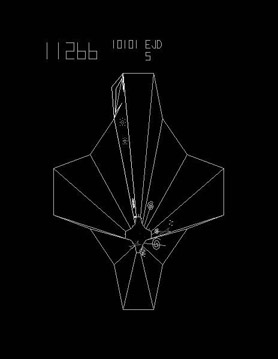Chapter 4: Game Analysis: Centipede
Overview
Designed by Ed Logg with Donna Bailey Released in 1981

One can think of the classic arcade game as a formof the computer game in the same way that a silent slapstick comedy is a form of film or the hard-boiled detective novel is a form of literature. The classic arcade game form fell out of favor with the commercial gaming companies pretty much as soon as the technology was available to move beyond it. However, many independent game developers still work on classic arcade games either for their own amusement or to be released as freeware or shareware titles. Many of these labors of love are imitations of established classic arcade games , but many others are interesting experiments in new gameplay. There remains something uniquely compelling about the form, and the fact that one does not need to have a sophisticated 3D engine to make a wonderfully entertaining classic arcade game helps to make the form an appealing one in which to work.
It bears mentioning that when I refer to the classic arcade game, I do not mean to imply that all classic arcade games are classics. Many of them are quite bad. As with any media, the old arcade games that are remembered and talked about decades after their release tend to be the best ones, thus creating the false impression of a golden age. The bad arcade games have fallen between the cracks of history. The term classic arcade game refers to the form as a classic one, not to the games themselves , just as one might refer to classical music. Surely the term arcade game is not limiting enough, since this would seem to include every game found in an arcade, including modern racing, gun, and fighting games, none of which are what I consider to be part of the form I am concerned with here.
The classic arcade game form had its commercial and creative heyday in the late 1970s through the early 1980s, when machines exhibiting the form lined the arcades. Looking at the games as a whole, one can come up with a series of traits that they all shared. Some of these aspects of the formmay have been arrived at because of the commercial considerations of the arcades. The thought was to get players to easily understand a game, so that by the end of their very first game they had a good sense of how the game worked and what was necessary for success. Second, the players game, even the game of an expert, could not last very long, since any one player had only paid a quarter, and if the game only earned a single quarter in a half hour , it would not be profitable to operate . The manufacturers of coin-op games wanted average play time to be 2.5 minutes. Players needed to be sucked in to replay the games, to keep plunking in quarters . As a result, in some ways the arcade games had to be more refined than home games are today. Once the players have purchased a home game, often for at least a hundred times the cost of a single arcade game play, the sale is completed. If they are not completely disgusted with the game they are unlikely to return it. Features such as scoring and high-score tables only served to increase the arcade game s addictive nature and encourage players to keep spending money.
In addition, the technical restrictions of the day limited what the games could do, and thereby influenced what the game could accomplish in terms of gameplay. Had the designers had the RAM and processing power to include fully scrolling game- worlds that were many times the size of the screen, they probably would have. If the games had been able to replay full-motion video of some sort , perhaps the designers would have incorporated more story line into the games. But the fact remains that a unique genre of computer games emerged, and if the commercial and technical limitations shaped the form, so be it. Just as early films had to work with the limitations of silence and short running times, computer game designers were limited in what they could create, and were able to come up with brilliant games nonetheless. Often, a series of strict constraints forces artists to focus their creativity in a fashion that leads to better work than if they could do anything they wanted.
One key ingredient to many classic arcade games was their wild variation in gameplay styles. Centipede , Missile Command , Pac-Man, and Frogger are as different from each other as they possibly could be. Many classic arcade games featured variations on a theme: Centipede , Space Invaders , Galaga , and Tempest all revolved around the idea of shooting at a descending onslaught of enemies. However, the gameplay variations these games embraced are far more radical than the tiny amount of variation one will find in modern games, which are more content to endlessly clone already-proven gaming genres. Despite the wild variety of gameplay that can be found in classic arcade games, one can still look back on these games as a collective and view them as an artistic movement in the brief history of computer games. By analyzing the form s shared traits, modern game designers can learn a lot about how they can make their own games more compelling experiences for players.

Tempest is one of many classic arcade games that is centered on shooting at enemies which keep getting closer. Tempest is memorable because of the many unique twists included.
EAN: 2147483647
Pages: 189